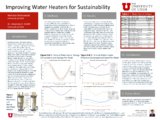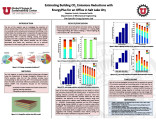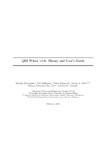1 - 25 of 11
| Creator | Title | Description | Subject | Date | ||
|---|---|---|---|---|---|---|
| 1 |
 |
Bianchi, Carlo | Energy demands for commercial buildings with climate variability based on emission scenarios | The impacts of a changing climate are wide-ranging in both impact and scope. This paper investigates the effect that realistic climate variability would have on building energy demands in Salt Lake City, UT to inform planning for air quality impacts. Energy demand scenarios were derived using climat... | BEM; EnergyPlus; Emissions; Climate; Energy | 2017 |
| 2 |
 |
Malinowski, Nicholas | Improving water heaters for sustainability | Buildings use about 40% of the total U.S. energy demand. Water heaters provide hot water for a variety of building uses including sinks, showers, dishwashers, washing machines, and space heating. Water heaters are the second most energy intensive appliances in a common household. Typically a home... | Water heaters; Energy efficiency; Electricity; Emissions; Natural gas | 2018 |
| 3 |
 |
Rahman, Aowabin | Predicting fuel consumption for commercial building with machine learning algorithms | This paper presents a modeling framework that uses machine learning algorithms to make longterm, i.e. one year-ahead predictions, of fuel consumption in multiple types of commercial prototype buildings at one-hour resolutions. Weather and schedule variables were used as model inputs, and the hourly ... | Building energy modeling; Machine learning; Prediction; Heating load; Data-driven modeling | 2017-08 |
| 4 |
 |
Lucich, Stephen; Smith, Amanda | Estimating building CO2 emissions reductions with EnergyPlus | The aim of this research is to investigate the potential to reduce greenhouse gas (GHG) emissions from the buildings sector in the Salt Lake Valley by altering the operational strategies of existing buildings. Air quality efforts typically focus on reducing emissions from transportation and industri... | Building energy modeling, Energy efficiency, HVAC, Greenhouse gas emissions | 2014-02-07 |
| 5 |
 |
Tran, Thomas T.D. | Thermoeconomic analysis of residential rooftop photovoltaic systems with integrated energy storage and resulting impacts on electrical distribution networks | This paper investigates residential rooftop photovoltaic (PV) systems for long-term thermoeconomic benefits from PV homeowners' perspectives and for impacts on the electrical distribution network from grid operators' perspectives. The costs of generating electricity from grid-connected PV systems ar... | Rooftop PV; Net Metering; Distribution Network; Energy storage; LCOE | 2018-07-07 |
| 6 |
 |
Tran, Thomas T.D. | Incorporating performance-based global sensitivity and uncertainty analysis into LCOE calculations for emerging renewable energy technologies | Assessing system costs for power generation is essential for evaluating the economical aspect of energy resources. This paper examines traditional and renewable energy resources under uncertainty and variability of input variables. The levelized cost of electricity (LCOE) of each technology is compu... | Renewable energy technologies; LCOE levelized cost of electricity | 2018-02-14 |
| 7 |
 |
Smith, Amanda D. | Modeling two-phase flow and vapor cycles using the generalized fluid system simulation program | This work presents three new applications for the general purpose fluid network solver code GFSSP developed at NASA's Marshall Space Flight Center: (1) cooling tower, (2) vapor-compression refrigeration system, and (3) vapor-expansion power generation system. These systems are widely used across eng... | Modeling; Fluid systems; Cooling tower; Vapor compression refrigeration, vapor power cycle | 2017-09 |
| 8 |
 |
Bozorgmehr, Behnam | QES-Winds v1.0: Theory and User's Guide | A new dispersion modeling system based on the well-used FORTRAN-based QUIC (Quick Urban and Industrial Complex) dispersion modeling system originally developed by the University of Utah and Los Alamos National Laboratory [1], has been under development as collaboration between the University of Utah... | 2021 | |
| 9 |
 |
Thomas, Tran T. D. | Evaluation of renewable energy technologies and their potential for technical integration and cost-effective use within the U.S. energy sector | Energy demands, environmental impacts of energy conversion, and the depletion of fossil; fuels are constant topics of discussion in the energy industry. Renewable energy technologies; have been proposed for many years to address these concerns. However, the transformation; from traditional methods o... | Renewable energy; Power generation; Electrical grid; Emerging energy systems; System integration | 2017-07 |
| 10 |
 |
Smith, Amanda D. | Performance modeling and parametric study of a stratified water thermal storage tank | Thermal energy storage (TES) can significantly increase the overall effciency and operational flexibility of adistributed generation system. A sensible water storage tank is an attractive option for integration in building energy systems, due to its low cost and high heat capacity. As such, this pap... | 2016-02-13 | |
| 11 |
 |
Rahman, Aowabin | Predicting heating demand and sizing a stratified thermal storage tank using deep learning algorithms | This paper evaluates the performance of deep recurrent neural networks in predicting heating demand for a commercial building over a medium-to-long term time horizon (≥ 1 week), and proposes a modeling framework to demonstrate how these longer-term predictions can be used to aid design of a strati... | Building Energy Modeling; Machine Learning; Recurrent Neural Networks; Deep Learning; Heating Load Prediction; Thermal Energy Storage | 2018 |
1 - 25 of 11
